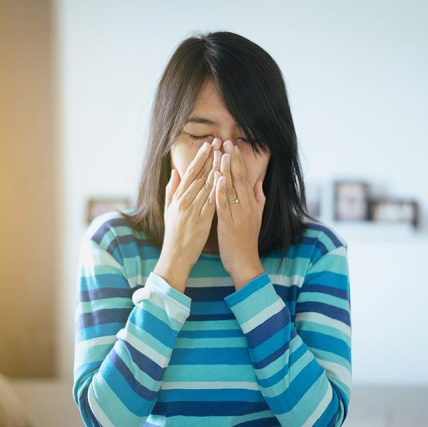Dry Eye Treatment in Mill Creek, Washington
What is Dry Eye Syndrome?
So many patients struggle with the discomfort and irritation caused by dry eyes. Various factors, such as age, menopause, certain medications, and medical conditions, can cause dry eyes. If you’re experiencing dry eyes in the morning or throughout the day, it’s essential to visit a dry eye doctor to receive a proper diagnosis and treatment plan.
Dry Eye Syndrome, referred to as DES, is a chronic eye condition that occurs when the eyes produce an insufficient amount of tears or when the tears lack the essential balance of elements to lubricate the eye’s surface. A well-lubricated eye blocks foreign bodies or substances from irritating the eye’s surface.
Dr. Fred Arima treats patients from all over Mill Creek, helping them achieve long-lasting relief from dry eye syndrome.


What Causes Dry Eye?
Dry eye can result due to a number of factors, including genetics, environment, the natural aging process, or prescription medications, to name a few.
Hormonal changes are a common cause of dry eye. In fact, women who are pregnant, breastfeeding, taking oral contraceptives, or experiencing menopause tend to experience the uncomfortable symptoms that accompany dry eye syndrome. Women over the age of 50 have double the risk of developing DES than men of the same age.
Meibomian glands are located by the eyelashes, towards the edge of the eyelid. These glands secrete oils, which lubricate the eye and keep your tears moist. When the glands become blocked, dry eye develops.
Common Dry Eye Symptoms
Patients with DES experience a number of symptoms that can disrupt their daily activities or cause chronic pain.
The most common signs of DES include the following:
- Blurriness
- Burning
- Dryness
- Feeling as if something is in your eye
- Irritation
- Itchy eyes
- Pain
- Red eyes
- Stinging
- Watery eyes
Those who suffer from DES often try to alleviate the pain by blinking either less or more often, rubbing their eyes, or by using over-the-counter artificial tears.
Why is blinking important? Blinking naturally moisturizes the eyes and gets rid of tiny particles that may enter the eye. Reduced blinking can increase dryness, itching, or redness, making DES symptoms even more acute.
Rubbing your eyes, especially when they’re already irritated, can intensify your symptoms. This is because the added pressure can make the pain worse. Moreover, if your hands aren’t 100% clean, you can unintentionally spread germs or bacteria into your eyes when you rub them. Rubbing the eyes can also cause tiny blood vessels to break, increasing the redness of your eyes.
Artificial tears provide temporary relief by lubricating the eyes with a specific solution. These can be quite effective at alleviating soreness and itchiness, however, excessive use isn’t recommended. Many brands include preservatives, which aren’t good for your health in the long term. Other preservative-free brands can, over time, fail to relieve the basic dry eye symptoms. Patients may find that having to continuously purchase artificial tears can become costly, and consistently using them throughout the day disrupts their daily activities.
Dry Eye Treatments
DES is typically treated with medicated eye drops, anti-inflammatory drops, or a heated compress. Occasionally, the eye doctor may recommend punctal plugs.
These are tiny devices that when inserted into the eye’s tear duct, block any drainage. This can alleviate DES symptoms by preventing moisture from draining out of the eye, ensuring that they stay inside the tear duct area. This increases the moisture level and provides longer-term relief.
Moreover, punctal plugs are not permanent and can be easily removed or replaced, making them a simple, affordable solution to alleviate symptoms. There are also many advanced treatments for Dry Eye, such as InflammaDry, LipiFlow, and TearLab.
In addition to the the above dry eye treatments, you may also benefit from using a dry eye relief mask, which helps to increase moisture around the eyes and reduce dryness, and to help manage your symptoms.

Dry Eye Technology
If you’re experiencing dry eyes, don’t suffer in silence! Advancements in medical technology and scientific breakthroughs have made treatment for dry eye easier, offering quicker results and longer-lasting benefits. Some of the latest technologies for DES treatment include InflammaDry, LipiFlow, and TearLab.
Mill Creek Vision has some of the most cutting-edge and advanced technologies to quickly and effectively test for Dry Eye Syndrome. Let Dr. Fred Arima and His experienced staff help get you started on the path to real long-term relief from dry eye.
Contact us today at Mill Creek Vision in Mill Creek to schedule an appointment and learn more about the different dry eye treatments available. We can help you find relief and enjoy clear, comfortable vision once again!
InflammaDry
Our tears contain a natural protein enzyme called matrix metalloproteinase-9, or MMP-9. Patients with Dry Eye usually have elevated levels of this protein.
The InflammaDry system measures MMP-9 levels by analyzing the tears taken from inside the lower eyelid. The entire process is fast and results are received in about 10 minutes. The disposable test is performed in the office, making it a top choice for eye doctors and DES patients.
LipiFlow
One of the latest advancements in dry eye treatment is LipiFlow technology. LipiFlow is a dry eye treatment that targets the root cause of evaporative dry eye disease, a common form of dry eye. LipiFlow is a painless procedure that uses thermal pulsation to remove blockages from the meibomian glands, which produce the oily layer of tears that keeps our eyes lubricated.
The LipiFlow dry eye treatment is highly effective and provides long-term relief for patients suffering from dry eyes!
OptiLight
A safe, mild, and successful method of treating dry eye is with OptiLight from Lumenis.
The first and only FDA-approved intense pulsed light (IPL) therapy for managing dry eyes is this non-invasive method, which alleviates the symptoms of dry eyes.
OptiLight delivers precise light pulses beneath the eyelids. The symptoms of dry eye are reduced with only a 10- to 15-minute treatment.
LipiScan Test
Before undergoing the LipiFlow dry eye treatment, we may recommend a LipiScan test to assess the function of your meibomian glands. The LipiScan test uses advanced imaging technology to capture high-definition images of your meibomian glands. This allows us to identify any blockages or abnormalities contributing to your dry eyes.
TearLab
The TearLab device measures concentration levels in human tears. This helps diagnose DES by noting any levels of tear concentration that are elevated, which signal dry eye.
TearLab is a 3-in-1 device: the test card, test pen, and countertop unit. The test card is a single-use microchip that collects a tiny sample of tear fluid in under 30 seconds. It sits inside the test pen, which analyzes and sends the data to the reader, located in the unit. The unit rests on a flat surface and displays the test results within seconds.










